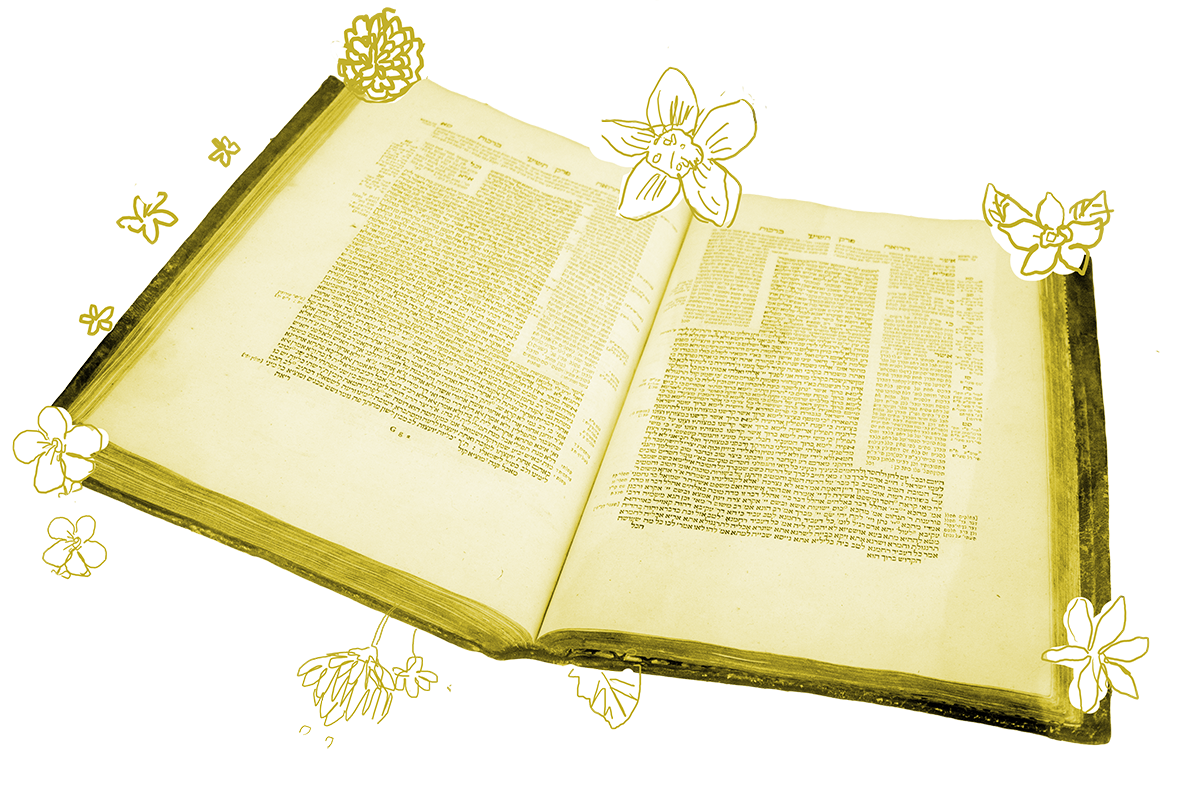Sukkot practice looked pretty different in Temple times. The fourth chapter of this tractate, which began with a mishnah at the bottom of yesterday’s page, fleshes out some of the unique Temple rituals.
Back when the Temple stood, the four species, the lulav and etrog were paraded around the altar as part of the elaborate Sukkot celebrations. In addition, part of the celebration involved surrounding the altar specifically with the arava, or willow branches — either by positioning them around the altar or by carrying them around by hand. There was also a special water libation and musical performances.
Today’s page teases out some issues around circling the altar with the lulav and circling it with the willow branches. In particular, both were supposed to happen on all seven days of the festival except, according to the mishnah, on Shabbat. The reason, the Gemara explains, is a concern that one will carry the lulav or willow branch on Shabbat. (This is also the reason one may not blow a shofar on Shabbat.)
There are two notable exceptions to the exception. If Shabbat coincides with the first day of Sukkot, then the ritual of carrying the lulav around the altar overrides it. And if Shabbat coincides with the seventh day of Sukkot, then the ritual of the willow branch overrides.
With your help, My Jewish Learning can provide endless opportunities for learning, connection and discovery.
In the midst of this discussion, Abaye brings us a story:
One time, the seventh day coincided with Shabbat, and the people brought the willow branches (to the Temple) on Shabbat eve, and placed them in the courtyard.
Carrying willow branches through Jerusalem is forbidden on Shabbat — it violates the prohibition on carrying in public spaces. But since, according to the rabbis, circling the altar with willow branches overrides Shabbat, the people make a special arrangement: They bring their willow branches the day before and stash them in the Temple courtyard. This seems like a great solution — until something goes wrong:
The Boethusians noticed them and took them and concealed them under stones.
Who are these trouble makers with the difficult-to-pronounce name? In the late days of the Second Temple, there were many Jewish sects that interpreted Jewish law in radically different ways. The Boethusians, who are mentioned in other sources, clearly did not agree that the willow branches should be carried around the altar on Shabbat. It’s not a crazy position. After all, the evidence that this ritual even derives from the Torah is very thin.
Back on Sukkah 34, Abba Shaul told us that the ritual is derived from a very close reading of Leviticus 23:40, which lists the four species bundled in the lulav. In that list, all the species are mentioned in the singular except the willow branches, which are stated in the plural. This, he explains, means that in addition to being part of the lulav, the willow branches are a ritual all their own. But the sages reject this clever way of reading the ritual into the Torah and simply say that the ritual of the willow branches is a halakhah from Moses at Sinai.
Either way, it’s not difficult to see why a non-rabbinic sectarian group like the Boethusians rejects the idea that this odd willow ritual is a mitzvah at all and so tries to prevent the Jews from performing it because, in their thinking, doing so would be a violation of Shabbat.
But it’s not just the Boethusians causing trouble for the rabbis. Reading on:
The next day, the idiots (amei ha’aretz) noticed (the hidden willow branches). And they extracted them from under the stones.
The implication in this passage is that the “idiots” knew that willow branches were meant to be carried around the altar that day, but they did not know they were not supposed to carry them in public. So they extracted the willows and carried them into the Temple, violating Shabbat. And the Temple priesthood went along with it!
And the priests brought them and stood them upright at the sides of the altar — because the Boethusians do not concede that waving the willow branch overrides Shabbat.
Instead of carrying the willow branches around the altar, the priests arranged them in a stationary display to appease the Boethusians, with whom they were likely more ideologically aligned.
In our journey through the Talmud, we’ve encountered many cases when the rabbis depict themselves as the religious authorities in the Temple. Here, they relate a story where they have completely lost control — to a rogue sect, to Jews who are not knowledgeable about Jewish law and to the priesthood. Then again, we wouldn’t even know about the incident today if it weren’t for the rabbis, so in the end perhaps they got the last laugh.
Read all of Sukkah 43 on Sefaria.
This piece originally appeared in a My Jewish Learning Daf Yomi email newsletter sent on August 19th, 2021. If you are interested in receiving the newsletter, sign up here.



